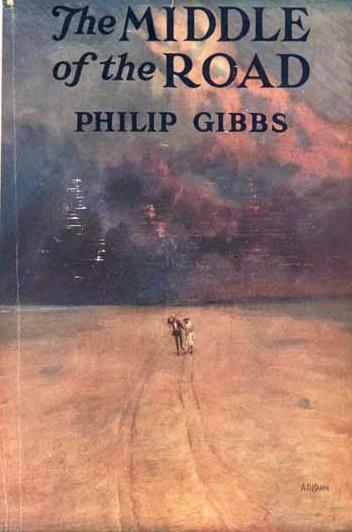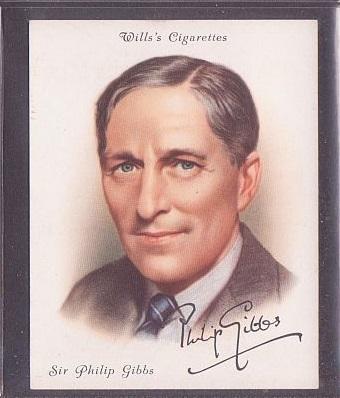Book Review by George S: Philip Gibbs was a so-so novelist, but a very good reporter. The saving grace of this 1922 novel is that in the second half, the reporter becomes dominant.
The novel is very much designed to explore the political issues of the day. Gibbs has been called a 'newspaper novelist', and much of his work has dated, in the way that last year's newspapers have become dated. Yet it's just this topicality that makes his novels, I think, essential reading for anyone who wants to understand the years in whuich he was writing.
 Cover of the first American edition
Cover of the first American edition
The book begins in the London of 1921, where unemployed ex-soldiers are begging in the streets, the rich are flirting with Mussolini's fascism, while fashionable socialists are entranced by Lenin and his Bolshevik utopia .
Bertram Pollard, an ex-officer with a 'nerve-tattered brain' has problems with his marriage and cannot find a job. His wife, who shares the values of her upper-class family, thinks he should do what his brother and other ex-officers have done, and join the Black and Tans, the paramilitary outfit that is inflicting savage reprisals on Irish rebels. Bertram is deeply unhappy with this suggestion, because he sees that the Irish nationalists have a case - but on the other hand he is uncomfortable when his sister asks him to shelter her husband, a Sinn Fein terrorist. He hears extreme views on both sides and feels some sympathy, but is always held back by his instinctive knowledge that every extreme point of view is matched by its opposite:
"God help Ireland-and England!" he said, and then lifted his hat and walked away. If he had been wholly Irish, he would have been Sinn Fein too. His passion would have flamed out for Irish liberty. But he was the son of an English mother, and loved England first and best. Why was he always pulled two ways? Why did this infernal tug-of-war go on in his heart and brain, between the extremes of thought? Most men walked on one side or the other, on their own side of life's hedge. He tried to keep to the middle of the road, and both sides flung stones at him.
"It's all very difficult!" he often remarks, and carries on gloomily.
The other great issue of the day is a potential miner's strike or lockout, which has the potential to become a General Strike. Once again, Bertram sees both sides of the argument. He argues fiercely against his wife's family, who want to use troops against the miners, but once agin his verdict is "It's all very difficult!"
Bertram is a gloomy and not very interesting personality and the people he meets are are mostly mouthpieces for attitudes rather than rounded characters. The book would have had much more resonance back in 1922, when its topics were still highly topical.The novel is saved half-way through, when he moves away from the England that he can no longer comprehend, and sees other parts of post-war Europe. The book mostly stops being a summary of other people's political attitudes, and becomes a record of things that Bertram has actually seen - and Philip Gibbs's reporter's eye can come into its own.
The first stop is Ireland, where he is present outside Mountjoy prison on the morning when a Sinn Fein man is hanged:
Between each prayer there rose another sound, the strangest, most terrible sound of a human kind that Bertram had ever heard beyond a battlefield. It was the wailing of women. It was like the cry of the Banshee, as he had imagined it with horror in childhood. It rose and fell in rhythmic anguish, from all those shawl-covered women, kneeling with bowed heads, or raising their heads and hands like a Greek chorus, to the heavens above. The search-light moved above them, touched their white hands, searched along the line of upturned faces, seemed to search their souls and reveal their passion. [....]
The soldiers in their shrapnel helmets and field kit stood motionless. Their helmets-the old "tin hats" of France and Flanders,-were touched at times by the white finger of light, and their faces were sharply illumined in those moments. Young, square-jawed, English faces. Now and again one of them pushed back some one in the crowd with the butt-end of his rifle, sharply, but without brutality. An officer passed down their lines, occasionally spoke a word of command.[...]
For the hundredth or thousandth time the words of the Rosary came from the kneeling crowd. A woman close to Bertram fell all huddled in a faint on the cold stones. Other women bent over her, loosened her shawl. A girl was sobbing loudly, with her face in her hands. A boy-a mere child-ended his prayer with a curse. "To Hell with England!"
Later Bertram is commissioned to travel through the countries of Europe as they try to recover from the war. England had been disturbed, but Bertram now visits countries that have suffered invasion, defeat, occupation or revolution.
His first stop is France, where he revisits the battlefields of the Somme, and remmebers the unity of purpose that held Britain and France together during the war. Now the French are suspicious of Britain, suspecting them of taking the German side over reparations. There is universal hatred for 'that monster, "Loy-Zhorzhe".'
From France he goes to Berlin, which seems superficially more prosperous - but the bright young things in the dance-halls are wearing shoes made of paper. The resentment that will flower into Nazism is detectable. Bertram deals firmly with someone claiming that the German Army was never defeated in the field, but he cannot help feeling some sympathy for the Germans, and he worries when he is told that the logical next step will be for them to make an alliance with the Russians.
The last quarter of the novel is easily the best, as it depicts Bertram's journey to report what is happening in Russia. (Bertram's journey is the same as that made by Gibbs, as descibed in his autobiography Now it can be Told.) From Riga he gets a lift on a train taking American emergency aid to Moscow, and begins to hear stories of the famine caused by the Revolution, and by Bolshevik policies. In Moscow, he is appalled by the universal poverty and by the raggedness and dirtiness of the people. He is especially touched by the members of rich and even aristocratic families who are now reduced to selling trinkets in the street. (This has only recently become legal, with the New Economic Policy, which tried to alleviate some of the worst economic effects of Bolshevism by allowing some private enterprise.) Those engaged in this kind of trade must be constantly careful, however, of the Cheka, the secret police.
In St Petersburg, things are even worse than in Moscow. Squalor, starvation, disease and the fear of police spies are everywhere. Bertram joins an American relief convoy to Kazan, one of the regions most struck by famine. These chapters make grim reading, especially the descriptions of an orphanage, and the women in a typhus hospital:
In ward after ward they saw the huddled victims of pestilence and famine. Their clothes had not been burnt, like those in the children's homes, and they were hunting vermin ceaselessly in their sheepskins and rags. It was difficult to give a guess at the age or class of these people. Young girls looked like old women. Young men had the worn, wrinkled look of extreme age. They were all reduced to a dead level of misery and squalor, and dirt; though among them, said Nadia, who spoke with many, were women of education and even of learning.
The last chapter of the book wraps up the story of Bertram's marriage difficulties very quickly, and in the most conventional conservative-middlebrow fashion. (He is ill, and she comes to his sick-bed with her love renewed.)
The book was a best-seller, going into several editions and selling some copies. Bertram may be a rather tiresome hero, but his dislike of all extremism must have been wisely shared in the 1920s. The second half of the book shows Gibbs at his best, as a writer who used his novels to inform, stimulate and educate his public.

